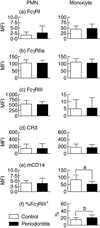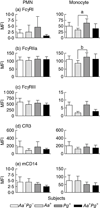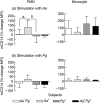Expression of FcgammaRs and mCD14 on polymorphonuclear neutrophils and monocytes may determine periodontal infection
- PMID: 18782328
- PMCID: PMC2612716
- DOI: 10.1111/j.1365-2249.2008.03751.x
Expression of FcgammaRs and mCD14 on polymorphonuclear neutrophils and monocytes may determine periodontal infection
Abstract
Variance in expression of receptors for immunoglobulin G (FcgammaRs), complement (CR3) and lipopolysaccharide (mCD14) on polymorphonuclear neutrophils (PMNs) and monocytes might affect susceptibility for infection with certain pathogens in periodontitis, a chronic infectious disease of tooth-supportive tissues. Levels of FcgammaRI, IIa, III, CR3 and mCD14 on PMNs and monocytes were measured in 19 periodontitis patients and 18 healthy controls. Subgingival infection with Aggregatibacter actinomycetemcomitans (Aa) and Porphyromonas gingivalis (Pg) was determined. Activation of PMNs and monocytes in response to stimulation with Aa and Pg was assessed by means of change in mCD14 expression. Periodontitis is associated with an enrichment of the FcgammaRIII(+) monocytes (P = 0.015) with concomitant low mCD14 (P = 0.001). Unadjusted data showed that the subjects culture-positive for Aa (Aa(+)) had significantly lower expression of monocytic FcgammaRI (P = 0.005) and FcgammaRIIa (P = 0.015) than Pg(+) subjects. The FcgammaRI was still lower on monocytes from Aa(+) subjects after adjusting for the background factors (P = 0.037). PMNs from Aa(+) subjects responded in a hyper-reactive manner, in particular when stimulated with Aa (P = 0.011). Lower FcgammaRs expression by monocytes is related to a higher susceptibility of a subject to become infected with Aa. The higher proportion of FcgammaRIII(+) monocytes may be involved in the chronicity of this condition. Hyper-reactive PMNs in Aa(+) subjects may contribute to accelerated breakdown of tooth-supportive tissues.
Figures





Similar articles
-
Periodontitis-associated pathogens P. gingivalis and A. actinomycetemcomitans activate human CD14(+) monocytes leading to enhanced Th17/IL-17 responses.Eur J Immunol. 2016 Sep;46(9):2211-21. doi: 10.1002/eji.201545871. Epub 2016 Aug 1. Eur J Immunol. 2016. PMID: 27334899 Free PMC article.
-
Neutrophils in chronic and aggressive periodontitis in interaction with Porphyromonas gingivalis and Aggregatibacter actinomycetemcomitans.J Periodontal Res. 2009 Jun;44(3):368-77. doi: 10.1111/j.1600-0765.2008.01113.x. Epub 2009 Feb 6. J Periodontal Res. 2009. PMID: 19210340 Free PMC article.
-
[Association between clinical parameters and the presence of Aggregatibacter actinomycetemcomitans and Porphyromonas gingivalis in patients with progressive periodontal lesions].Vojnosanit Pregl. 2010 Nov;67(11):898-902. doi: 10.2298/vsp1011898r. Vojnosanit Pregl. 2010. PMID: 21268925 Serbian.
-
The role of the cell-mediated immune response to Actinobacillus actinomycetemcomitans and Porphyromonas gingivalis in periodontitis.Periodontol 2000. 1999 Jun;20:239-88. doi: 10.1111/j.1600-0757.1999.tb00163.x. Periodontol 2000. 1999. PMID: 10522228 Review. No abstract available.
-
Oral ecology and person-to-person transmission of Actinobacillus actinomycetemcomitans and Porphyromonas gingivalis.Periodontol 2000. 1999 Jun;20:65-81. doi: 10.1111/j.1600-0757.1999.tb00158.x. Periodontol 2000. 1999. PMID: 10522223 Review.
Cited by
-
Novel Assay To Characterize Neutrophil Responses to Oral Biofilms.Infect Immun. 2019 Jan 24;87(2):e00790-18. doi: 10.1128/IAI.00790-18. Print 2019 Feb. Infect Immun. 2019. PMID: 30455195 Free PMC article.
-
Distal Consequences of Oral Inflammation.Front Immunol. 2019 Jun 25;10:1403. doi: 10.3389/fimmu.2019.01403. eCollection 2019. Front Immunol. 2019. PMID: 31293577 Free PMC article. Review.
-
Endotoxin and CD14 in the progression of biliary atresia.J Transl Med. 2010 Dec 21;8:138. doi: 10.1186/1479-5876-8-138. J Transl Med. 2010. PMID: 21172039 Free PMC article.
-
Epistatic Association of CD14 and NOTCH2 Genetic Polymorphisms with Biliary Atresia in a Southern Chinese Population.Mol Ther Nucleic Acids. 2018 Dec 7;13:590-595. doi: 10.1016/j.omtn.2018.10.006. Epub 2018 Oct 16. Mol Ther Nucleic Acids. 2018. PMID: 30439647 Free PMC article.
References
-
- Slots J. Update on Actinobacillus Actinomycetemcomitans and Porphyromonas gingivalis in human periodontal disease. J Int Acad Periodontol. 1999;1:121–6. - PubMed
-
- van Winkelhoff AJ, Loos BG, van der Reijden WA, van der Velden U. Porphyromonas gingivalis, Bacteroides forsythus and other putative periodontal pathogens in subjects with and without periodontal destruction. J Clin Periodontol. 2002;29:1023–8. - PubMed
-
- Ebersole JL, Taubman MA, Smith DJ, Frey DE, Haffajee AD, Socransky SS. Human serum antibody responses to oral microorganisms. IV. Correlation with homologous infection. Oral Microbiol Immunol. 1987;2:53–9. - PubMed
-
- Van Dyke TE, Levine MJ, Genco RJ. Neutrophil function and oral disease. J Oral Pathol. 1985;14:95–120. - PubMed
-
- Page RC, Schroeder HE. Pathogenesis of inflammatory periodontal disease. A summary of current work. Lab Invest. 1976;34:235–49. - PubMed
Publication types
MeSH terms
Substances
LinkOut - more resources
Full Text Sources

